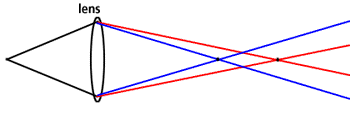Performance
There
are many characteristics that determine the performance
of a telescope. They are below with a description.
Chromatic
Aberration
This
phenomena is caused by the fact that different wavelengths
of light bend in materials at different angles (The Refraction
of Light Part II). For instance, blue bends in glass with
a different angle than red does due to the fact that blue
light has a shorter wavelength than red light. This is the
main reason that we can see "the green flash", but unfortunately,
it also is the main reason for the hated purple fringe that
surrounds most bright celestial bodies in the more inexpensive
lines of refracting telescopes. In order to correct this
phenomenon, either expensive fluorite glass or assemblies
that have multiple lenses that bend the different wavelengths
of light so that they will have the same focal length must
be utilized. A diagram of this problem can be seen below.

Image courtesy of Refraction
of Light Part II
Air
Turbulence
Air
turbulence within a telescope's optical system is the number
one killer of optical performance for a perfectly collimated
telescope. This air turbulence is caused when a telescope
is brought from a warm environment to a cold one or vice
versa. When the telescope is brought from the warm to the
cold, the air inside the tube is cooling down, but it is
cooling down unevenly. Air in the top region of the tube
near the sides will get cold and become denser, moving down
to the bottom region. This cycle continues and the end result
is that, when one looks at a planet or star, it will look
blurry and detail-less. One will see "waves" moving across
the image, like the heat waves one sees rising up from asphalt
on a hot day.
Collimation
If
the optics within a telescope system do not align perfectly,
then the cone of light that hits the eyepiece will not be
aimed dead center. This will cause a certain "fuzziness"
to be introduced to the image and could even cause double
images in severe cases. It can also cause stars to be "smeared"
or "streaked" at the outer edges of the field of view.
Vignetting
Vignetting
occurs when the field of view at the eyepiece is not fully
illuminated. This can be caused by several factors, the
primary of which is that the diameter of the tube just before
the light cone reaches the eyepiece is too small. This size
limitation clips off the outer edges of the light cone,
causing a darkening around the edges of the field of view.
(Vignetting Caused by the Limiting Aperature of Various
Tubes and Adapters)